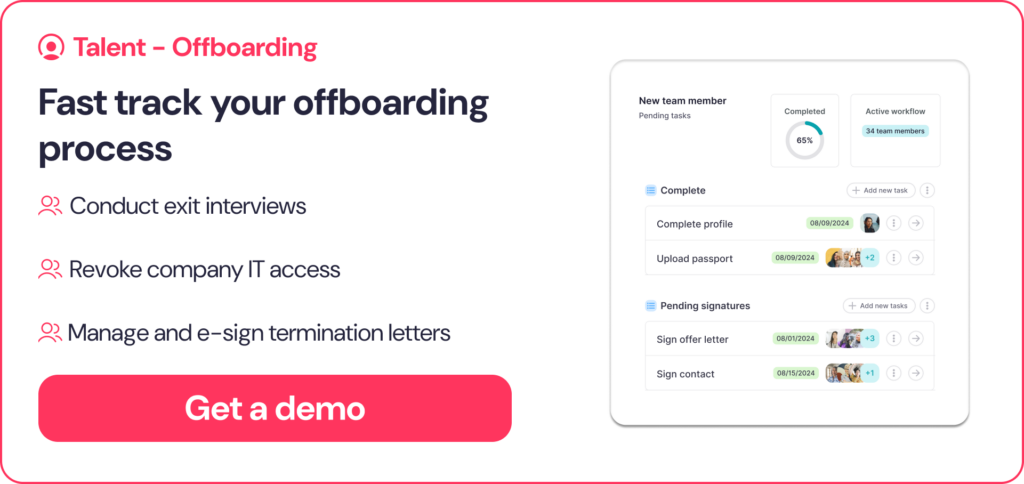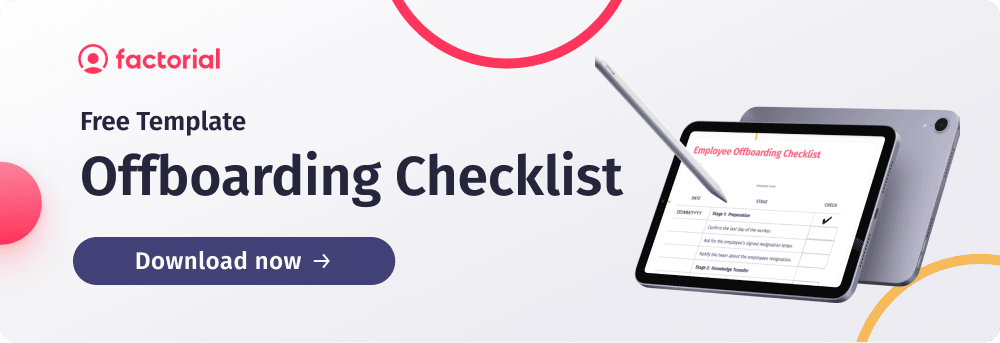Voluntary redundancy is one option for employers to consider when HR managers are faced with a tough choice. It’s important to understand the legal nuances when offering voluntary redundancy to avoid any potential legal disputes. In this article, we’ll go over the definition of voluntary redundancy, what employees and employers should know, and an outline step-by-step of the process.
TABLE OF CONTENTS
- What is Voluntary Redundancy?
- Employee Rights in Voluntary Redundancy
- Essential Information for Employers
- Voluntary Redundancy: Step-by-step Outline
- Transform your business with Factorial 🚀
What is Voluntary Redundancy?
Redundancy is one method employers use to dismiss employees. Voluntary redundancy occurs when an employee chooses whether to leave the company or stay in employment. A financial incentive is often attached to voluntary redundancy. A financial package can be an excellent option for people who want to leave the company or are near retirement age.
It is different from compulsory redundancy when the employee has no choice about whether they leave their role.
Companies will usually offer voluntary redundancy when they need to reduce costs, restructure roles or change the location of employment. Offering voluntary redundancy can be the first phase of significant changes to the structure of an organisation. Organisations can reduce their headcount without impacting individuals for whom compulsory redundancy would be highly stressful by offering voluntary redundancy as an option first.
Your Rights as an Employee
As an employee, you have redundancy rights. These are the same regardless of whether you choose voluntary redundancy or are being made redundant as part of a compulsory process.
Your rights include:
- Reasonable time off to look for a new role or attend training to enhance your skills
- A written explanation of the redundancy pay calculation
- The first £30,000 of the package is free from tax and national insurance payments
You may be offered a severance package which enhances the statutory pay. As part of this package, it is common for an employee to agree to give up rights such as the ability to claim unfair dismissal.
As an employee, you must weigh the pros and cons of taking voluntary redundancy. You may consider taking voluntary redundancy for several reasons, including:
- You are entitled to statutory redundancy pay if you have worked for a company for two years or more and are choosing to accept the option of voluntary redundancy.
- The opportunity to change roles while having financial support from the redundancy package
- A lifestyle change such as retirement, caring or parenting
- Using the redundancy package to start a new business
Essential Voluntary Redundancy Information for Employers
As an employer who is starting to consider making people redundant, it’s essential to understand the voluntary redundancy rules.
Ensure you understand the legal requirements when making employees redundant. These include:
- Consulting with all affected staff.
- Using collective consultation rules if there are more than 20 employees affected by the offer of voluntary redundancy.
- Providing clear and accessible information on who is eligible for voluntary redundancy, the financial package offered and how you will decide who receives it.
- Establishing the timeframe gives employees time to consider their options and seek independent advice.
- Being able to pay statutory redundancy pay as a minimum requirement.
- Ensuring there is a fair selection process and no potential for discrimination.
- Informing employees about their right to access benefits and support such as Jobseekers Allowance.
Employers starting a voluntary redundancy process should also ensure that the process is genuinely voluntary and that no one feels pressured into accepting a package.
The financial package should include details of:
- Statutory pay
- Enhanced redundancy pay
- Notice period
- Holiday pay
- Other contractual benefits
If you are an employer considering a voluntary redundancy programme, you must be aware that you may find employers opting for voluntary redundancy who you do not want to lose. To avoid scenarios where employees get their hopes up about leaving and then have to stay in a role they no longer wish to be in, companies can use a scoring framework that provides transparency about the process and decision-making to all involved.
Related: Download a FREE offboarding checklist.
Step By Step Process for Voluntary Redundancy
A voluntary redundancy programme must follow the same process as compulsory redundancies. The UK government lays out the redundancy process on their website.
It’s a good idea to document every stage of the process and all communications with employees, including informal ones. Written documentation helps ensure that you are following due process and treating your employees fairly. It also acts as a safety net in case of misunderstandings, as you’ll have all communication on record to prove your compliance if legal disputes arise.
1. Identify the need for redundancies and plan the programme.
Before you start, it is essential to know why you need to make redundancies and how you will run the programme to ensure that you are fair, transparent, and able to communicate effectively in difficult circumstances.
2. Evaluate why redundancies are necessary (eg, costs, technological improvements, structural changes).
Understanding why redundancies are necessary will help you plan strategically. You’ll be able to manage your budget accordingly and make informed decisions on how vital operations.
3. Determine the impact (ie, which roles) and whether alternatives are available.
Establish whether the role an employee is doing is no longer relevant to the company. Or new systems and technologies are in place which eliminates a specific role.
4. Create a redundancy scheme
You can create a redundancy scheme by establishing an appropriate timeframe, confirming the criteria you will use to decide who to offer voluntary redundancy to, and clarifying the package you can offer.F
5. Communicate with employees.
How you communicate with your employees at the start of the process will significantly impact how well the whole programme runs. Spend time on a communication plan and ensure senior stakeholders and line managers understand the rationale behind the redundancy programme.
Communication to your employees needs to be transparent. Include the following information:
- Why redundancies are happening
- Who is eligible
- The decision-making process
- The details of the financial package
- The timeline
- Any support available
Organisations should supply written documentation to each employee so they can take it away and consider their options with the information they need.
6. Receive and assess applications for voluntary redundancy.
At this stage, employers should receive applications for voluntary redundancy by a set deadline. The key decision-makers should review each application using pre-established criteria. When this work is complete, a list of employees who have successfully applied for voluntary redundancy will be available.
Not all applications for voluntary redundancy schemes will be successful. Creating criteria to decide who is successful can help companies avoid losing people they want to keep. For example, the requirements may determine that specific departments cannot lose a certain number of employees.
If there are not enough applications for voluntary redundancy, the company may need to start a compulsory redundancy programme.
7. Communicate to employees
All employees who have opted for voluntary redundancy should receive a communication within the agreed timeframe. For those who have not been successful in their applications, it is essential to consider how best to communicate this information. Realising they cannot leave with the package they had hoped for may impact morale.
The company must issue a formal redundancy notice to employees accepted for voluntary redundancy. The formal notice includes the last working day, the redundancy pay details, and any outplacement support.
8. The exit process
At this stage, companies need to do several things:
- Calculate and pay the final salary payment (including redundancy pay, notice pay and any outstanding holiday pay)
- Issue a P45 and any relevant tax documentation
- Provide support such as services to help with job searches, CV writing and training
Organisations may also want to give employees access to assistance programmes such as counselling or financial advice and conduct exit interviews with them.



